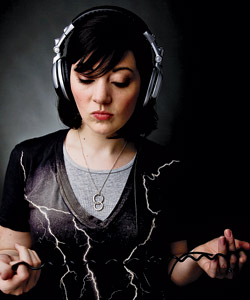 * Mourning Becomes Electra: Christine Pawlak, better known to Q101 listeners as Electra (and Chicago readers as our 2008 pick for the city's best radio DJ), has a piece in Slate today about the death of Q101 and the decline of rock radio. It's not just a lament for her old station, but also a good overview of the format today. It made me sad because of the parallels to my own industry, and because, as a wise man once said, everyone's a critic and most people are DJs (see also: "and Ellen Foley gives 'em hope"). One of my regrets from college is not parlaying my role as barista/DJ into a gig at WHPK, which was one story up from the coffee shop where I worked.
* Mourning Becomes Electra: Christine Pawlak, better known to Q101 listeners as Electra (and Chicago readers as our 2008 pick for the city's best radio DJ), has a piece in Slate today about the death of Q101 and the decline of rock radio. It's not just a lament for her old station, but also a good overview of the format today. It made me sad because of the parallels to my own industry, and because, as a wise man once said, everyone's a critic and most people are DJs (see also: "and Ellen Foley gives 'em hope"). One of my regrets from college is not parlaying my role as barista/DJ into a gig at WHPK, which was one story up from the coffee shop where I worked.
What I know from my years as a DJ is that listeners know what they like when they hear it. Q101 fans reached out en masse during our last days, sharing their memories of the station’s almost 20-year run. Chicago natives who’d moved away for jobs, school, or military service listened via Q101.com and sent us heartfelt emails and texts. Even now, I get choked up reading the hundreds of comments on my old Facebook page: “I feel like I've lost my best friend.” “You have no idea how much we'll all miss you guys.” “A big piece of my generation's life just died.” Then, there’s this: “Sure, the iPod can play music, but nothing can replace the personality that you brought to the station.”
It's a dilemma for radio. Employing people to present music requires an audience of a certain size to sell ads to. Technology has fractured radio's audience, not just in terms of access but also taste. When I was 15, Addicted to Noise, the first online music mag to include audio bits (32 kbps RealAudio, IIRC) debuted, and it obviated my need for Rolling Stone, which I would read in the library to find out about hep new music. ATN had stuff like Freakwater and made fun of stuff like Dave Matthews, and in a city with no college radio or independent music stores it was the first way around the gatekeepers I'd ever encountered. Mind you, this was three years before the first portable media player, but the seeds were sown.
But people are starting to rebuild music communities from the technologies that are slowly eliminating FM radio: here in Chicago, besides our ongoing college radio concerns, there's CHIRP, the Chicago Independent Music Project, and the newish, locally-focused Chicago Mixtape. The long-running New York/New Jersey freeform station WFMU has embraced the Web, running the popular site WFMU's Beware of the Blog.
And there's public radio: KCRW's Morning Becomes Eclectic is in its third decade, and Sound Opinions remains, to my knowledge, the world's only rock 'n' roll talk show. Should WBEZ ever consider its own takeoff on Morning Becomes Eclectic, there's a host in town with a following and an appropriate DJ name.
* "Midwest Electric: The Story of Chicago House and Detroit Techno": PRI's Afropop Worldwide takes a long look at how contemporary dance music emerged from gay and black Midwestern subcultures during the 1980s. Meanwhile, DuttyArtz has some raw oral-history audio from Willis Glasspiegel, the producer of the documentary, about the arcane Chicago art of footwork and juke. Glasspiegel also captured some excellent video (h/t @Sam_Eck).
* The Ball Scene: Tangentially related: "Grit & Glitter," an excellent Chicago Reader cover story by Elly Fishman, on the city's underground ball scene.
Like the Finnie Balls, today's ballroom competitions are partly a response to the fact that poor, black, gay kids have few places where they can mix with Chicago's broader gay community. Recent violence and protests in Boys Town suggest that that community is as racially and economically segregated as the rest of the city. But with segregation comes congregation, and balls are where gay black kids can find one another.
It's a fascinating story of how the city's interracial drag balls of the 1920s-1960s merged with the New York-born art of voguing into a competitive dance style and community.
* Nico Muhly: I second Peter Margasak's recommendation of the Chicago premiere of a choral work by young composer Nico Muhly. It's at the Harris Theater tonight at 7:00 pm.
* "String Theory and the Science of the Violin": In case you missed it, this Chicago piece on a Chicago doctor and his decades-long quest to master violin construction is excellent.
He focused on altering the thickness in precise locations, just millimeters apart, in the instrument’s curved plates—on the right side opposite the left strings, the left side opposite the right strings—that balanced the action of the corresponding string. “When I realized that the shape and thicknesses of the back of the violin were determined by the need to conserve momentum for each string and required exquisite adjustment,” he says, “I realized that I had both an explanation and a method.” This was science. He could test the epiphany.
Photograph: Joe C. Moreno; Hair and makeup: Sara Saltanovitz/Artists by Timothy Priano



